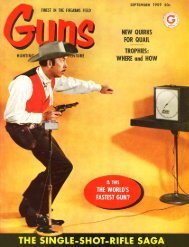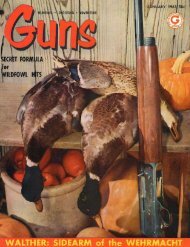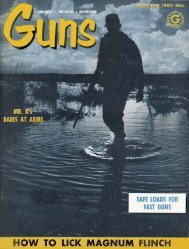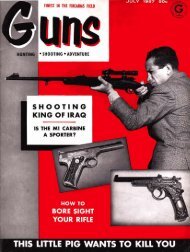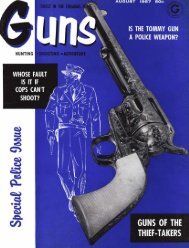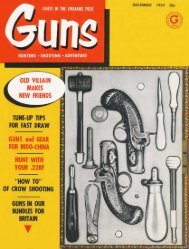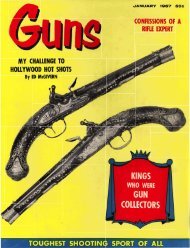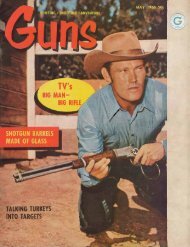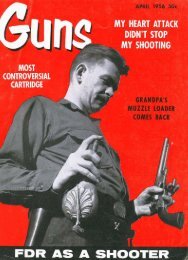You also want an ePaper? Increase the reach of your titles
YUMPU automatically turns print PDFs into web optimized ePapers that Google loves.
uiijition shooters are tricks, dependent on<br />
sheer deception. Remember, please, that the<br />
exhibition shooter is, necessarily, highly<br />
skilled, even if (as is not by any means<br />
always the case) he deceives you on some<br />
of his shots. The magician deceives you a<br />
thousand times as often, and you like it. You<br />
don't question the magician's skill; don't<br />
question that of the shooter.<br />
The fact that the thread he cuts with a<br />
bullet is actually a wider target than you<br />
thought doesn't mean that the shooter<br />
cheated you; it means that you just never<br />
thought about the width of the bullet.<br />
Shooting a gun held upside down is really<br />
no harder than shooting one held right-sideup,<br />
except for possible awkwardness of<br />
position; you use the same sights in both<br />
case. True, the point of bullet impact has a<br />
different relationship to the sight picture,<br />
simply because the sights are set to allow<br />
for the pull of gravity when the gun is<br />
upright and this allowance is reversed then<br />
the gun is turned over-but you allow for<br />
this by holding a bit high and your shot<br />
scores. This, in itself, might be called<br />
"trickery," but it isn't; it's simply "gun<br />
savvy."<br />
On the other hand, hitting a mark by<br />
sighting through a mirror, or by target<br />
reflection in a diamond ring, are exactly as<br />
difficult as they look-not because the shots<br />
require more gun skill than shots normally<br />
sighted, hut simply because it takes a lot<br />
of practice to learn to move your sights into<br />
alignment while seeing them "in mirror<br />
image." Everything works backward! Try it,<br />
and you'll see.<br />
Almost without exception, you can believe<br />
what you see when the shooter starts busting<br />
aerial targets. Much has been made of the<br />
story, whether true or false, that certain<br />
showmen of the past "use fine shot instead<br />
of bullets~threw a 'pattern' so wide they<br />
just couldn't miss!" Some of the "debunkers"<br />
claim they shot "cartridges loaded with salt."<br />
The story needs to be taken with a grain of<br />
salt, truly-or at least with a seasoning of<br />
gun savvy. Even a .44 or .45 caliber cartridge<br />
loaded with the finest shot won't throw a<br />
pattern wider than a few inches at the<br />
ranges used in the exhibitions in questionand<br />
flipping shot within even a few inches of<br />
aerial targets requires some degree of skill.<br />
And nobody I know, certainly none of the<br />
publicized exhibitionists, use powder-shot<br />
today. They don't have to. They can, and<br />
do, hit with bullets.<br />
s ome exhibition shooters "spice" their performances<br />
with the element of danger.<br />
Whether the danger is great or small<br />
depends on the circumstances; the important<br />
thing is that the audience believes the danger<br />
is there. And it is. I question the need for<br />
adding "thrill" to skill by shooting targets<br />
out of a ~erson's mouth or fingers. No man<br />
yet born is totally immune to the possibility<br />
of either accident or error, and a very small<br />
accident or a very small error can produce<br />
tragedy when a gun is pointed within inches<br />
or less of a human body. It takes exactly as<br />
much skill to clip a cigaret held to a board<br />
by a spring clip as to clip one held between<br />
the lips of a pretty girl-and the former<br />
makes a lot more sense. One accident with a<br />
gun outweighs a million shots safely fired, in<br />
public opinion; and the shooting sports are<br />
heavily affected by public opinion<br />
To misquote a much quoted and some-<br />
times ridiculed advertisement, "You, too, can<br />
be an exhibition shooter." All it takes is<br />
practice. And practice. And more practice.<br />
And if you love shooting, the practice is<br />
almost as much fun as the accomplishment.<br />
If you want to learn to hit aerial targets,<br />
remember that "trigger control" is of just<br />
as much-more-importance here as it is in<br />
shooting at stationary paper targets. Any<br />
slight wrong movement of the trigger finger<br />
will produce a miss. To be sure, there isn't<br />
time for the slow sque-e-e-e-ze of paper target<br />
slow fire when you're shooting at flying<br />
targets; but there must not be any trigger<br />
ierk, either. You must learn to fire with a<br />
- .<br />
fast, smooth pull. Double-action shooting is<br />
Trap ti at all angles, lets<br />
shooter practice without an assistant.<br />
the best way I know to learn how to operate<br />
the trigger of a revolver quickly and<br />
smoothly. And remember, too, that the<br />
trigger release must be smooth also. It<br />
must be as smooth as the pull, else the shot<br />
will be deflected.<br />
Strengthening your trigger finger will help<br />
you a lot in double-action shooting, especially<br />
for fast double action. I spent many hours<br />
practicing with an old, worn out, double<br />
action revolver which has a trigger pull of<br />
nearly fifteen ~ounds.<br />
it is needed, not only in the trigger finger<br />
but in other parts of the hand where muscle<br />
is needed for fast, smooth, double action<br />
shooting.<br />
Position (stance) is important in aerial<br />
shooting. I try never to move my gun hand<br />
and arm independently after they reach<br />
approximate shooting position; I follow the<br />
target, making sighting adjustments, by<br />
moving my body. I lean back a little to<br />
follow a rising target, tip forward slightly to ,<br />
follow a falling target. By so doing, I am<br />
able to keep my eyes aligned with my sights.<br />
Turning a little to the left or right makes<br />
the gun follow a crossing target. Body<br />
balance must be perfect, and the shooter<br />
should approach every shot with his feet<br />
properly placed, his body poised, relaxed,<br />
with no muscular tension but "cocked,"<br />
ready for instant, easy movement. A little<br />
experimenting will tell you what is the best,<br />
most comfortable stance for you. Adopt that<br />
position and stick to it.<br />
You'll miss ,'em, in the beginning. Even<br />
if you're Dead-eye Dick on the 10-ring,<br />
you'll miss the flyers until you get the feel of<br />
it. But don't give up; keep trying. You say<br />
you've already kept trying to the extent<br />
of a dozen boxes of cartridges and you still<br />
can't hit a quart can in the air consistently?<br />
W-e-1-1 . . . maybe I left out a point of<br />
interest. Did I tell you how much ammo I<br />
expended before I got somewhere fairly close<br />
to my own ideas of what constituted a good<br />
exhibition shooter? Maybe this will make<br />
you feel better. As I recall it, I used roughly<br />
a bit over 15 casemr more than 150,000<br />
rounds. And I enjoyed every shot.<br />
What did I prove? Well, maybe nothing of<br />
earth-shaking importance; only that an<br />
ordinary guy can shoot better than Wild<br />
Bill Hickok, if he works at it. He should; .<br />
he has the advantage of better guns and<br />
better ammo. All it takes is-more practice.<br />
But be sure you remember, first, last, and<br />
always, to be careful! A bullet in the leg<br />
taught me that lesson; you can learn<br />
with less bloodshed. And you can have<br />
more darn' fun than a barrel of hn<br />
It puts muscle where monkeys!<br />
Non-Breakable, Guaranteed<br />
For All American, Many Foreign Guns<br />
Non-slip and precision-fitted, FRANZITE GRIPS an<br />
the most durable model Beautiful colon; smooth,<br />
checkered. . staahom - and fancy cawed; . truly . distincfive.<br />
Long-wearing, unaffected by moisture, perspiration,<br />
most mineral and vegetable oils. Will not<br />
chip or peel. Luster, color are permanent.<br />
Conventional or conversion styles. Also target grips.<br />
with or without thumb rest. Available for all popn-<br />
lor guns in: Ivory, Pearl, Onyx, Agate, Walnut,<br />
Black and Staghorn finishes. Low cost, $2.50 to<br />
S8.00ÑSe our complete catalfgl<br />
framite Grips Am Sdd Under Our Guarantee<br />
.-.#<br />
Write today for 28-page book. Remington~rowning Luger<br />
FREE Prices, illustrate! grips for all Rugat Czech<br />
CATALOG American makes, plus many far- Signdtrd eg &,sà !:$,"<br />
eign.<br />
Iver-Johnson Walthor Llama Webley<br />
Ad Many OHnn<br />
SPORTS, INC* 5501 Bmadway,Dept.CH-3,Chicago 40,111.<br />
m<br />
I





